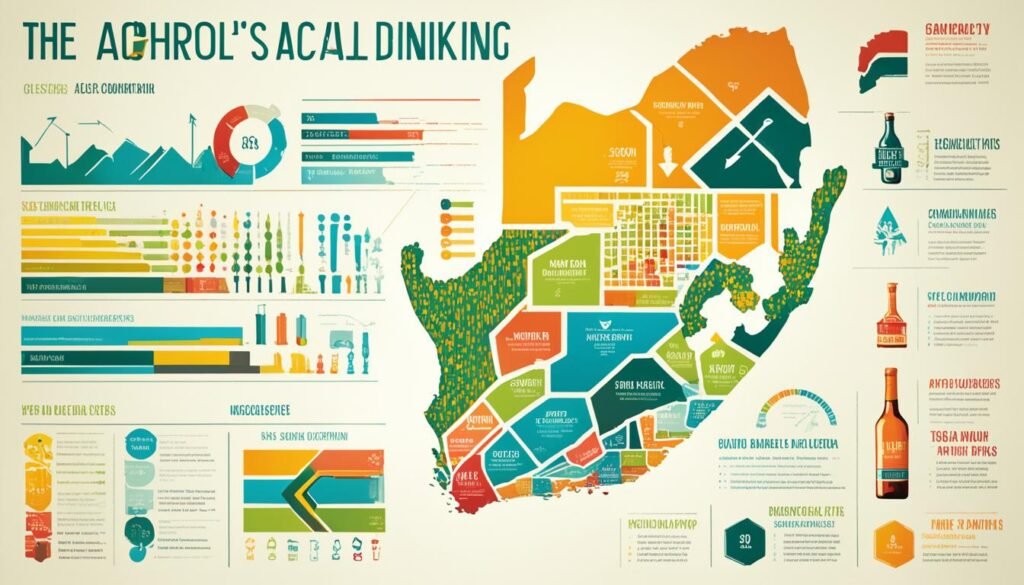In a recent roundup of South Africa alcohol consumption records, a specific locale has surfaced as the town with the most alcohol consumption in South Africa. This town isn’t just leading by marginal numbers but holds a significant lead, positioning it as South Africa’s top alcohol-consuming town. Diving into the habitual patterns of this bustling community, one comes to understand not just the numbers but also the cultural and societal influences that contribute to the title it now holds.
The reputation that follows this town is one flavored heavily by Black Label beer—a beverage of choice that tracks back through the country’s history as a staple in social and leisure environments. Reporting can illuminate the dynamics that allow such consumption to thrive in this urban center, revealing checks and balances necessary to understand the context of these findings.
Key Takeaways:
- Understanding the drinking culture offers insights into South Africa’s most alcohol-consuming towns.
- Local preferences, such as the selection of specific beverages, can influence overall alcohol consumption patterns.
- Public health implications arise from the metrics indicating heavy alcohol consumption within the community.
- Recognizing the town with the highest intake is crucial for targeted interventions.
- Comprehensive data helps to consider policy changes and address alcohol-related societal impacts.
Unveiling South Africa’s Premier Alcohol-Consuming Town
In the quest to determine which town drinks the most alcohol in South Africa, extensive research has brought Tshwane into the spotlight. With its vibrant nightlife and widespread availability of alcoholic beverages, this town has surfaced as a critical point of focus for those monitoring alcohol consumption by town in South Africa. Tshwane’s culture and social settings have contributed to its ranking as the highest alcohol consumption town in South Africa.
Metrics Defining the Leading Town
A study examining the drinking habits of various South African towns has shed light on the alarming rates at which some urban areas consume alcohol. Tshwane stands out, with an estimated 53% of the sample population being classified as heavy drinkers according to the study’s criteria.
| Factor | Percentage (%) | Definition of Heavy Drinking |
|---|---|---|
| Heavy Drinkers in Tshwane | 53 | 96g+ of alcohol for men, 72g+ for women monthly |
| Risk of Chronic Diseases | High | Associated with heavy drinking |
| Interpersonal Violence | Increased Probability | Correlated with heavy drinking episodes |
This table delineates the substantial prevalence of heavy drinking in Tshwane, spotlighting the urgency for public health interventions.
Impact of Cultural and Social Dynamics
The cultural context and social habits deeply influence patterns of consumption. Factors such as marital status, chosen locale for drinking, and even the size of the container from which beverages are consumed have significant bearings on the incidence of heavy drinking.
- Marital Status: Single or divorced individuals tend to report higher alcohol consumption levels.
- Drinking Location: Alcohol consumed in social settings such as bars or clubs often contributes to higher quantities being ingested.
- Container Size: Larger containers can lead to increased consumption due to the perception of volume versus content.
Understanding these dynamics is critical in formulating effective strategies to reduce the impact of alcohol consumption on the community.
Understanding Heavy Drinking Patterns in South Africa

The continuous monitoring of South Africa drinking statistics highlights a notable trend of heavy drinking patterns in South Africa, which has become a critical issue for public health authorities. To fully comprehend these patterns, demographic data has been pivotal in revealing that predominantly young, male individuals residing in urban areas are frequent heavy drinkers. Such insights are critical for developing targeted intervention strategies.
Popular social haunts like nightclubs and sports clubs emerge as common settings where this demographic engages in heavy alcohol use. With the rise of nightlife culture in urban settings, these venues have become significant contributors to the growing concern around responsible drinking habits.
Policy interventions are key to managing and hopefully reducing the prevalence of these drinking patterns. Discussions on alcohol policy reforms are currently underway, with measures such as raising the legal drinking age and enforcing stricter controls on the proximity of alcohol outlets to sensitive areas like schools and religious places being considered.
| Demographic Group | Prevalence of Heavy Drinking | Preferred Drinking Locations |
|---|---|---|
| Youth (18-35 years) | High | Nightclubs, Bars, Sports Clubs |
| Men | Higher than Women | Taverns, Shebeens, Private Social Gatherings |
| Urban Residents | More Prevalent than Rural | Entertainment Districts, Urban Nightlife Zones |
Any successful strategy will not only require the implementation of such policies but also an active engagement with communities. Education on the dangers of excessive alcohol consumption, combined with support systems for those struggling with alcohol dependence, will be essential in changing the current
heavy drinking patterns seen across South Africa
.
Which town drinks the most alcohol in South Africa?
Delving into the data surrounding South Africa alcohol consumption, a notable pattern emerges with the Tshwane Metropole positioned at the forefront, earning the title for alcohol consumption by town in South Africa. This distinction is not just about the volume but also the frequency of heavy drinking events that have placed Tshwane under scrutiny.
Investigating further into the practices of alcohol consumption within this region, a significant correlation becomes apparent between the demographic factors – such as age, race, and income levels – and the tendency towards heavier alcohol consumption.
| Drinker’s Profile | Preferred Alcohol Type | Typical Consumption Frequency | Average Container Size |
|---|---|---|---|
| Young Adults | Beer | Weekends | Large Bottles/Cans |
| Mid-aged Professionals | Wine | 2-3 times per week | Standard Bottles |
| Elderly | Spirits | Occasionally | Small Flasks |
These findings present a vivid snapshot of the prevailing trends in South Africa alcohol consumption, especially the intense concentration within Tshwane Metropole. It underscores a broader narrative about alcohol consumption by town in South Africa, demonstrating the need for targeted intervention strategies.
Breaking Down South Africa’s Drinking Statistics

Exploring the intricate landscape of South Africa alcohol consumption reveals more than just surface-level data. It uncovers a complex pattern of drinking behaviors deeply embedded across towns and cities. A particularly enlightening aspect is the average alcohol consumption per adult drinker. With a sobering abstention rate of 73%, it’s the quantity consumed by those who do indulge that paints a vivid picture of the situation.
Comparative Analysis of Alcohol Consumption by Town
Drilling down into the variations of alcohol consumption by town South Africa, the statistics draw a striking contrast. Tshwane emerges from the data as a significant hotspot, standing out with its high prevalence of alcohol intake. This town’s consumption levels are not just a local outlier but also hold their own in regional and global contexts.
Historical Trends and Current Consumption Patterns
South African drinking statistics also bring to light the changes over time in alcohol consumption patterns. While societal shifts and legislative measures have influenced drinking behaviors, there remains a consistent trend among certain demographics, pointing to enduring patterns of heavy alcohol use.
| Town | Historical Consumption Level | Current Consumption Level |
|---|---|---|
| Tshwane | High | Very High |
| Cape Town | Moderate | High |
| Durban | Low | Moderate |
Contributing Factors to High Alcohol Consumption in South Africa
Understanding the multifaceted reasons behind South Africa alcohol consumption requires looking beyond surface statistics to consider deeper socio-economic conditions and policy frameworks. These elements serve not only to contextualize the consumption patterns but also to identify potential interventions.
The Role of Economic and Policy Influences
The Economic impact on alcohol consumption South Africa faces is significant. Financial considerations influence drinking habits, as the cost and availability of alcohol affect how much and how often people drink. Additionally, governmental policies, such as taxation and regulations regarding alcohol sales, have a direct correlation with consumption levels. South Africa’s approach to these economic policies shapes the landscape of alcohol consumption, sometimes leading to unintended consequences such as the growth of informal markets.
Unrecorded and Informal Alcohol Consumption: A Hidden Challenge
A sizable portion of South Africa’s drinking data involves unrecorded alcohol consumption, escaping official records and complicating efforts for effective regulation and taxation. These uncharted territories of consumption provide a shield for both the economic and health impacts of alcohol to burgeon unchecked, necessitating urgent attention from policymakers and community leaders alike.
| Aspect of Consumption | Impact on South Africa | Percentage of Total Intake |
|---|---|---|
| Recorded Sales | Monitored; subjugated to taxation and regulation | 73.7% |
| Unrecorded Sales | Escapes regulation; potential health risks | 26.3% |
| Economic Policy Decisions | Can reduce or increase consumption | Varies |
| Informal Market Growth | Undermines formal market; tax revenue loss | Not quantified |
Effects of Alcohol Consumption on South African Society
The immoderate South Africa alcohol consumption effects are a multifaceted issue, with significant implications for the public health system. One of the gravest outcomes is the prevalence of fetal alcohol spectrum disorders, a condition that not only challenges the healthcare industry but also places undue strain on families and educational systems.
Alcohol-related harms in South Africa also manifest in various social dimensions, such as increased instances of interpersonal violence and heightened rates of accidents and injuries attributable to alcohol use. Such societal issues are further compounded by the loss of productivity in the workforce, leading to an overarching economic burden.
While the personal toll on individuals and families is often highlighted, the economic implications represent a hidden but profound consequence of excessive alcohol consumption.
The following table outlines some significant statistics detailing the economic and societal impact of excessive alcohol consumption in South Africa:
| Impact Area | Statistics | Remarks |
|---|---|---|
| Healthcare Costs | Increased by 20% | Treatment of alcohol-related health issues has grown noticeably. |
| Productivity Losses | Estimated 10-12% of GDP | Labor force productivity is significantly hampered by alcohol usage. |
| Fetal Alcohol Spectrum Disorders | Highest reported rates | South Africa has some of the highest incidences worldwide. |
| Interpersonal Violence | Linked to 40% of cases | Alcohol consumption is a contributing factor to various forms of violence. |
As South Africa alcohol consumption effects continue to place strain on public resources and societal welfare, the importance of targeted interventions becomes increasingly apparent.
Conclusion
The extensive scrutiny into South Africa alcohol consumption issues has brought to light a troublesome scenario. Data reveals that individual and societal norms surrounding alcohol intake have fostered an environment where excessive drinking is commonplace, especially in the city of Tshwane. It has become clear that the current state of affairs in terms of alcohol consumption is not sustainable, with a pressing need for strategic and actionable reforms. Addressing the patterns that lead to heavy drinking and the resulting social impact requires a meticulous and all-encompassing approach.
Reduction of alcohol harms in South Africa is not a task that falls upon a single entity but is a responsibility shared by the community at large. From government bodies to local health organizations, a synergistic effort is necessary to engineer effective public policies, establish preventive measures, and provide support to those grappling with alcohol dependence. By fostering a collective drive towards change, South Africa can engender an environment focused on healthful living and community welfare.
The culmination of these efforts should aim not only to reduce the tangible problems associated with alcohol consumption but also to cultivate healthier habits that span generations. Understanding the intricate ties between consumption behaviors and societal repercussions is the first step towards a future where the deleterious effects of alcohol do not undermine the vibrancy and potential of South Africa’s towns and cities. With determination and unified action, it is plausible to envision a South Africa where alcohol harms are significantly diminished, elevating the well-being and quality of life for all its citizens.
FAQ
What town in South Africa has the highest alcohol consumption?
Tshwane has been identified as the town with the highest alcohol consumption rates in South Africa.
What are the defining metrics for leading alcohol consumption in South African towns?
The defining metrics include the percentage of heavy drinkers, the volume and frequency of alcohol consumption, and the types and sizes of alcohol containers used.
How do cultural and social dynamics impact alcohol consumption in South Africa?
Cultural and social dynamics, including drinking locations like nightclubs and sports clubs, marital status, and container sizes play a significant role in the heavy drinking rates in South African towns.
What are the heavy drinking patterns in South Africa?
Heavy drinking patterns in South Africa are characterized by consumption of large quantities of alcohol, especially in urban areas among young males, who typically indulge in drinking at specific locations like nightclubs.
How does South Africa rank globally in terms of alcohol consumption?
South Africa ranks sixth globally regarding alcohol consumption per drinker per day.
How does alcohol consumption in South African towns compare regionally and globally?
Despite a high abstention rate, the average alcohol consumption per adult drinker in towns like Tshwane is remarkably high, indicating that South Africa has notable levels of consumption compared to regional and global standards.
What are the historical trends in alcohol consumption in South Africa?
Historical trends show a deep-rooted pattern of heavy alcohol use, with a high quantity of alcohol consumption among drinkers, despite the significant percentage of the population that abstains from alcohol.
What economic and policy factors contribute to high alcohol consumption in South Africa?
Economic factors such as the availability of alcohol and socio-economic status, along with the need for stringent alcohol policies, contribute to the high levels of alcohol consumption in South Africa.
How significant is unrecorded and informal alcohol consumption in South Africa?
Unrecorded alcohol consumption is a significant challenge, accounting for 26.3% of the total alcohol intake in South Africa, much of which comes from informally produced alcohol.
What are the effects of alcohol consumption on South African society?
The effects include serious health issues like fetal alcohol spectrum disorders, interpersonal violence, sexually transmitted infections, and economic strains costing about 10-12% of the nation’s GDP.
